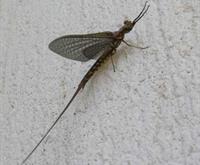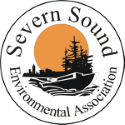Are Mayflies "Bugging" Your WaterFront?
The invasion of the burrowing mayflies – the long-tailed insects plaguing the waterfront homes and businesses of Severn Sound – is a sure sign of summer. While some people don’t like the sight of mayflies clinging to their walls and windows, this annual event is a welcome sign of a healthy ecosystem. In fact, SSEA uses the mayfly as an indicator of healthy lake bottom conditions.

Often called shadflies or fishflies, the proper name for this group of aquatic insects is Hexagenia, or burrowing mayflies. For two or three years, they live in a juvenile form called a nymph, burrowing in the soft sediment at the bottom of the lake. Around this time of year, they wriggle out of the mud and swim to the lake’s surface. If they survive the trip without becoming fish food, they shed their nymphal skins (seen floating on the water or washed up on the beach, and often mistaken for dead minnows) twice before finally emerging in the winged adult form.
The adult mayfly has a limited lifespan, and will only travel a certain distance away from the shoreline. They have no mouthparts, so they do not eat (or bite). They emerge only to mate and die soon after laying their eggs.
Why do we want to see mayflies in Severn Sound? Since mayflies live in the sediments, their presence is a sign that the lake bottom is fairly clean and well oxygenated. They are also a very important food source for fish such as perch and walleye in their larval stage, and birds in their adult stage. Larval mayfly populations can be affected by low bottom water oxygen levels, water pollutants such as oil and heavy metals, invasive species and habitat destruction.
Reference: – Mackie, G. 2002. Applied Ecosystem Concepts. Kendall Hutt Publishing Co. Iowa. pp 744.


